Soldering is Easy Heres How to Do It
A new soldering iron tip melts through solder like butter, and creates joints with consummate ease. That's a perfect setup to lull you into a false sense of complacency, which invariably leads to a lack of tip cleaning and maintenance. It doesn't take long for your soldering iron tip to resemble a fireplace poker left overnight in the bowels of Mount Doom.
Forget perfect joints: an oxidized tip has a hard time melting solder. While tip cleaning is the obvious solution, restoring a severely charred tip isn't exactly straightforward. Fortunately for you, we know just how to get it all shiny and clean.
Why Cleaning a Soldering Iron Is Important
An oxidized tip makes it impossible to create reliable solder joints, because the tip is surrounded by an insulating layer comprising oxides, charred flux residue, and assorted impurities. A strong solder joint requires the heated tip to form a "heat bridge" between the components, with the molten solder serving as the conduit for heat transfer.
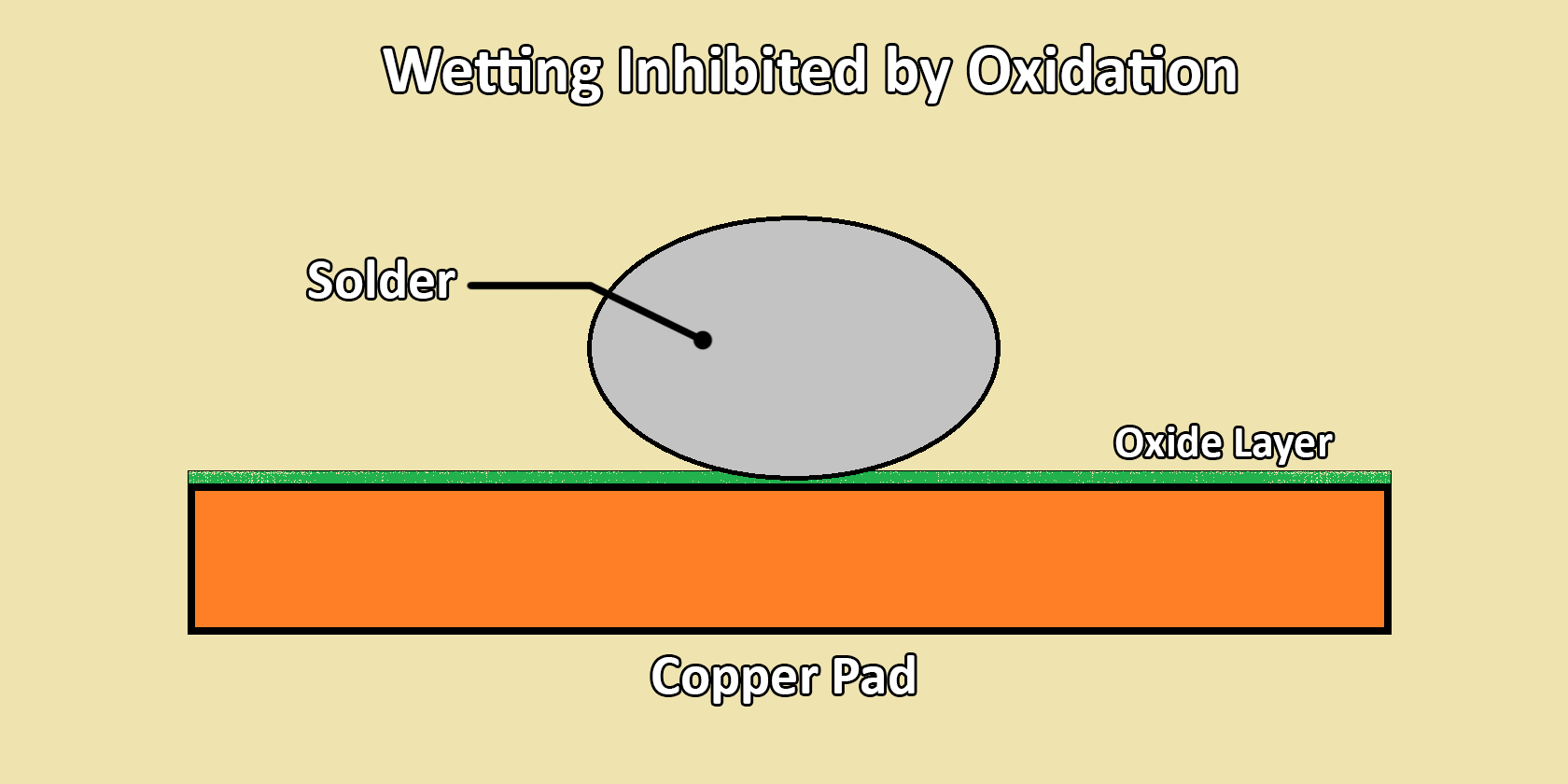
An oxidized tip prevents this process since that transforms it from an ideal conductor of heat to an insulator. Our soldering basics guide covers the science behind this process in great detail.
Mechanically Cleaning Soldering Iron Tips
Tip cleaning strategies vary according to the severity of oxidation. If the tip of your soldering iron exhibits an impenetrable armor of insulating oxides, resorting to mechanical cleaning agents might be the only viable solution. This must be the last resort, because there's a high risk of abrading the protective nickel plating on the iron tip. The tip is practically useless without it. Exercise restraint and be gentle while cleaning the tip.
Green Scotch-Brite Scouring Pad
A much safer alternative (relatively speaking) involves using the green Scotch-Brite branded scouring pad. These employ man-made polymers that gently remove the loose oxide layer without harming the nickel plating. Grip the soldering iron tip with the scouring pad and rotate it along the axis of the tip to clean it. This process must obviously be done with the soldering iron switched off and the tip at room temperature.
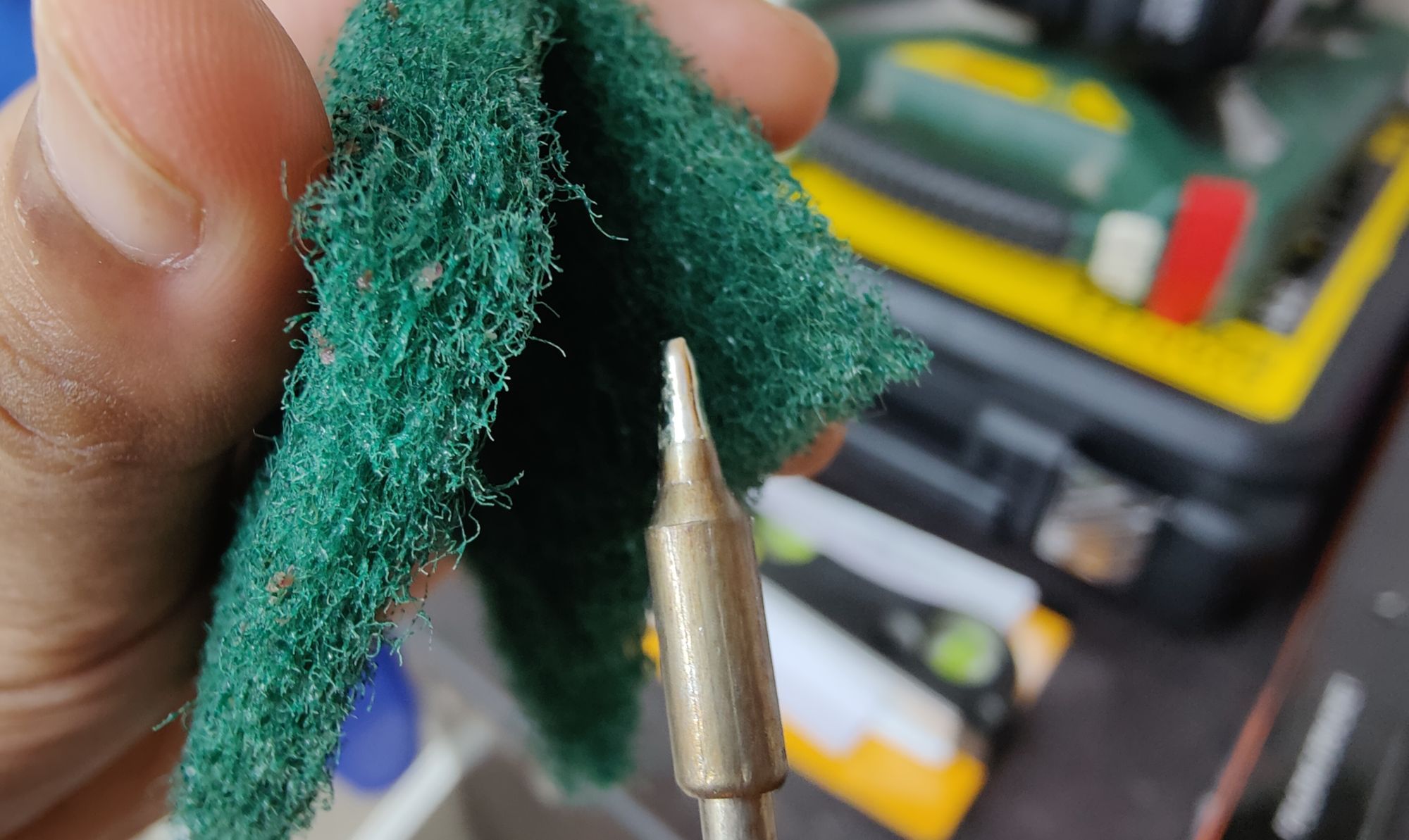
Be sure to tin the tip with fresh solder after cleaning it. This is important because the cleaning process removes the protective solder layer, without which the tip is susceptible to further oxidation. Be sure to repeat this step for all other tip cleaning methods that follow.
Brass Brush
If Scotch-Brite doesn't help, turning up the heat might be in order. That's within the realm of possibility once you replace the polymer-based Scotch-Brite pad with a brass brush. The bristles must be made of brass, because steel ones will chew right through the nickel plating on the soldering iron tip. Brass works because it isn't hard enough to harm the plating.
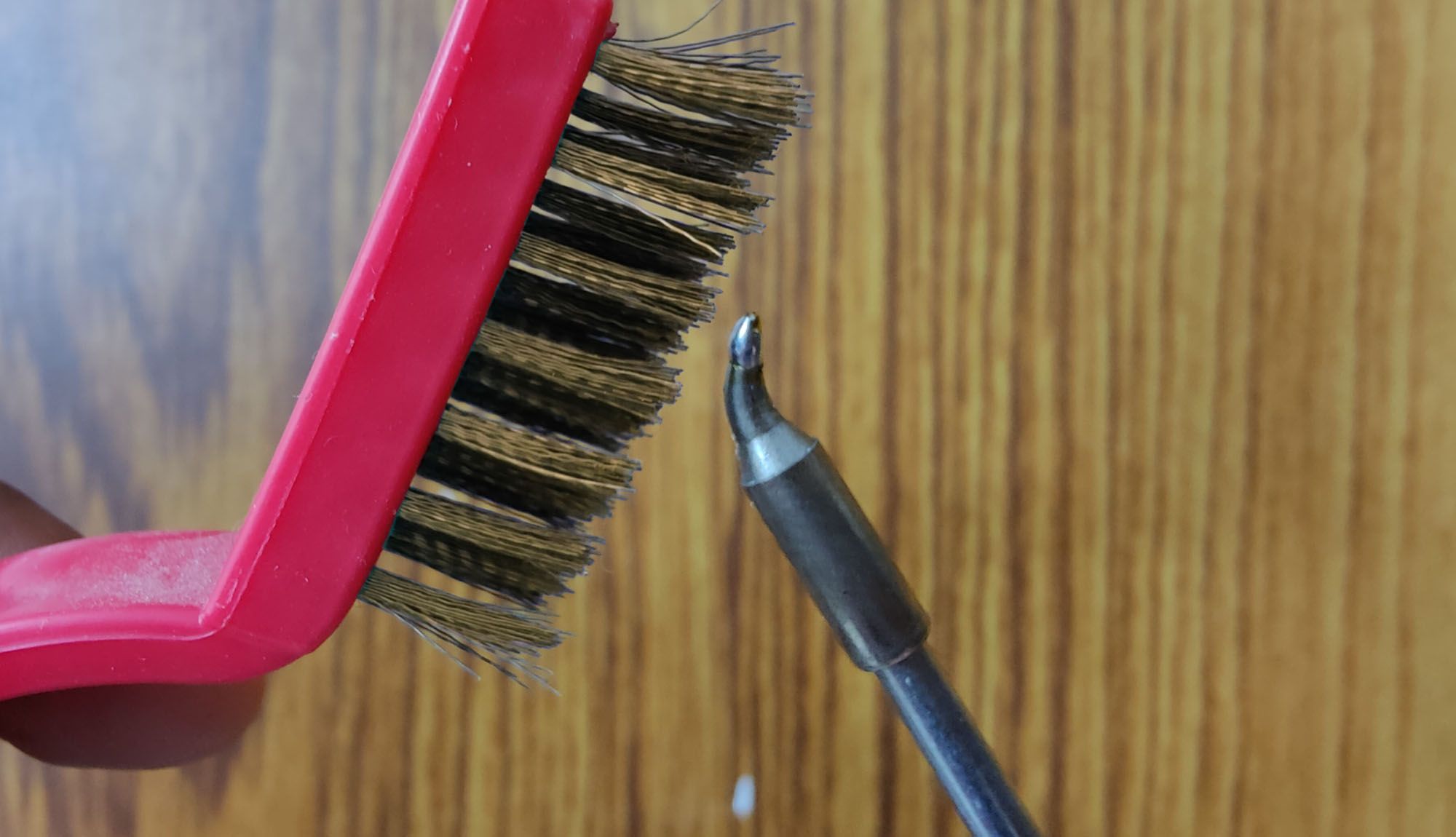
Heat the iron to soldering temperature. Apply a liberal amount of rosin flux on the brass brush and scrub the tip until it is clean. You may have to make several passes with the brush, but be sure to reapply flux with each pass.
Weller Polishing Bar
Noted soldering brand Weller sells polishing bars specifically made for refreshing soldering iron tips. Using them involves gently scraping the tip against the bar to remove the oxide layer. This process is usually performed with a cold tip, but tougher residue can be removed by heating the iron to soldering temperature.
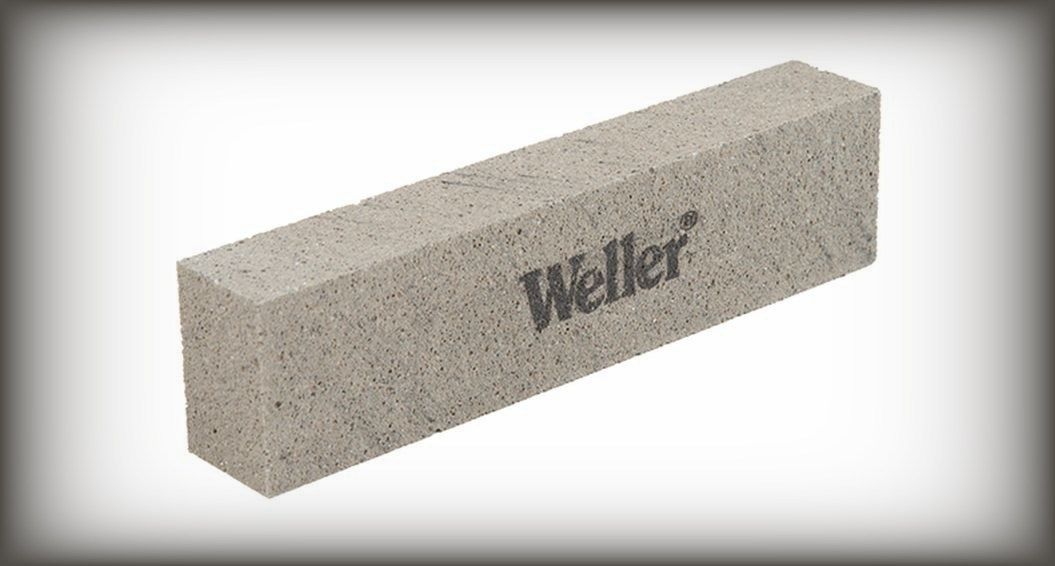
It must be noted that other soldering iron brands such as Hakko, Pace, Metcal, and JBC do not sell such abrasive bars due to the high risk of ruining the nickel plating on the tip. This approach must, therefore, be your final resort after exhausting all other alternatives.
Safer Approach to Clean a Soldering Iron Tip
If your soldering iron's tip isn't horribly oxidized, you might want to try these traditional (and significantly safer) alternatives before resorting to harsher mechanical cleaning alternatives listed above.
Soldering Sponge
Soldering sponges are distinct from regular sponges made from man-made materials. These sponges are fashioned out of sulfur-free cellulose that won't melt onto the tip or coat it with contaminants. These are lightly moistened (can't be dripping wet!), which subjects the hot tip to a mild thermal shock. The ensuing phase change of the water when it hits the tip is violent enough to remove the oxide layer and other contaminants.
Employing this approach involves heating the iron to soldering temperature, followed by dipping it in a flux container. If you are using liquid flux, a drop or two on the hot tip works as well. Immediately rub the tip onto the moist sponge a few times. Depending on the level of tip oxidation, this should expose some amount of silver tip underneath the dark oxide cladding. If not, repeat the process until that happens.
Once you punch through a bit of the oxide layer, use this opportunity to melt either 60/40 solder or 63/37 lead solder (bearing a rosin core) onto the cleaned part of the tip. Again, rub the tip clean on the sponge. The rosin core solder wire cleans the tip further and widens the gaps in the oxide layer. Repeating the process a few times should leave you with a shiny tip that's as good as new.
Brass Tip Cleaner
Alternatively, you may even use a brass tip cleaner instead of the soldering sponge. These tip cleaners are fashioned out of thin coils of brass wire that's lightly coated with rosin flux. A brass tip cleaner might seem more aggressive compared to a sponge, but it is actually gentler on the tip despite the greater mechanical rubbing action.
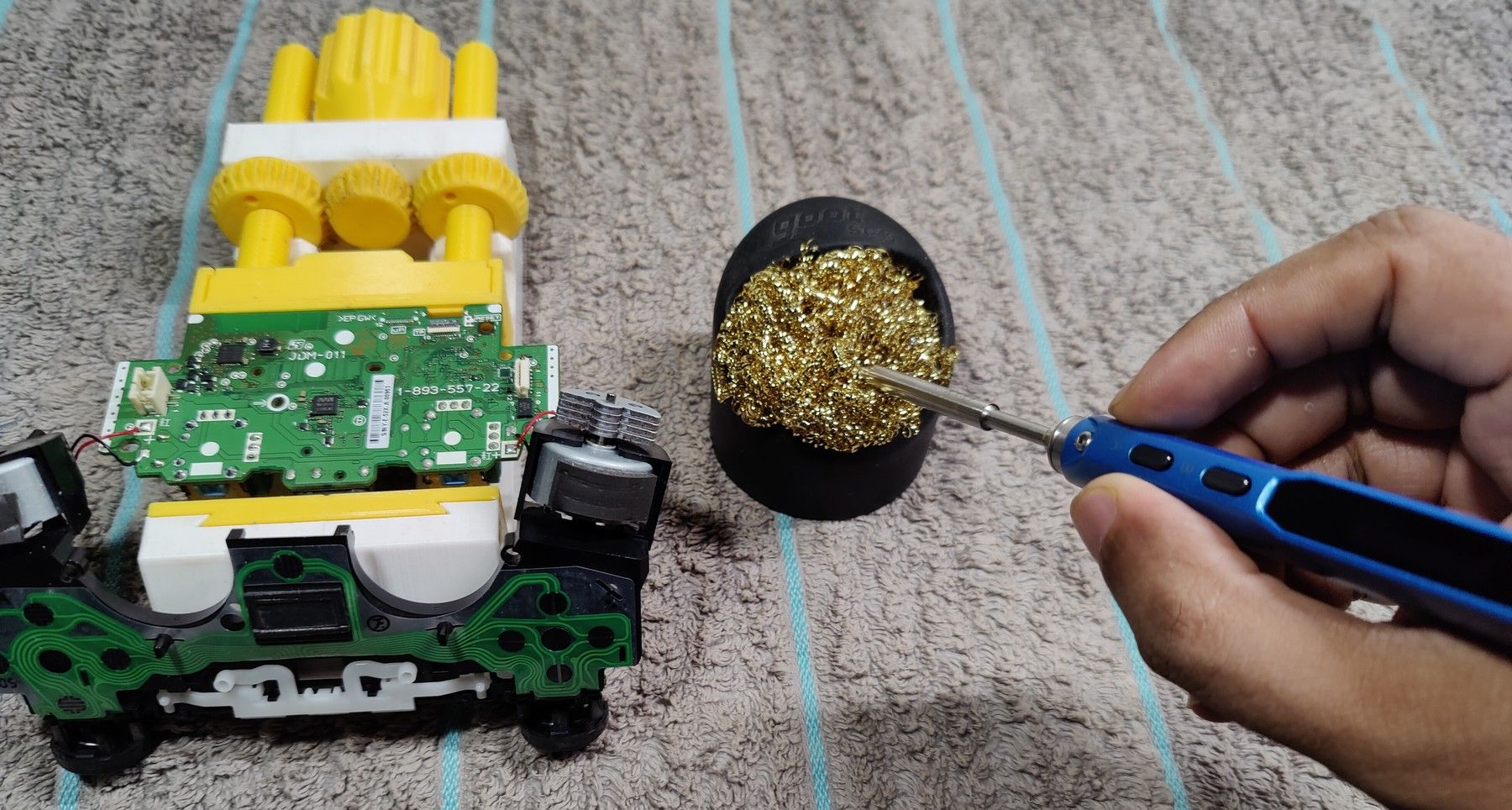
The actual tip cleaning process is the same as above, except you gently poke the tip into the brass wool instead of rubbing it on moist sponge.
Motorized Tip Cleaner
For even more aggressive cleaning, you have the option of using motorized tip cleaners instead of brass wool. These devices utilize brass brushes rotating at high speeds to clean the tip. As with the last tip cleaning approach, follow the same procedure detailed in the soldering sponge technique. The only difference is replacing the sponge with the motorized tip cleaner.
Tip Tinner or Tip Cleaning Paste
This is often confused with soldering flux used during the regular soldering process to catastrophic effect. Tip tinners, or tip cleaning pastes, have little in common with flux used while making actual solder joints. The former is used exclusively to chemically scrub stubborn oxide layer off ruined tips.
Tip tinners are therefore loaded with extremely aggressive acids and other nasty chemicals that differ from one brand to another. Use them sparingly and only on excessively oxidized tips.
Heat the tip to soldering temperature and insert it vertically into the tip cleaner container. Let it rest for a few seconds before wiping it clean in a soldering-grade, pure cellulose (sulfur-free) sponge that has been moistened lightly.
A lot of tip cleaning guides recommend using plumber's paste instead of a soldering-grade tip tinner. That's a terrible idea because plumber's paste is extremely corrosive in order to braze copper piping effectively. Using it on soldering irons will rapidly deteriorate the tip and significantly reduce their service life.
Failed to heed this warning? Here's what to look out for when buying a new soldering iron.
Alternatively, you may use brass or motorized tip cleaners (detailed above) instead of the moist sponge. Don't forget to re-tin the tip once it has been cleaned.
Regular Tip Tinning Prevents Oxidation
Cleaning a badly oxidized soldering iron tip isn't impossible, but it sure isn't easy or pleasant either. Cultivating a habit of regularly re-tinning the tip goes a long way towards preventing it from getting oxidized. Melting a blob of solder onto the tip before stowing it away also eliminates the risk of oxidation over time.
Source: https://www.makeuseof.com/how-to-clean-your-soldering-iron/
Post a Comment for "Soldering is Easy Heres How to Do It"